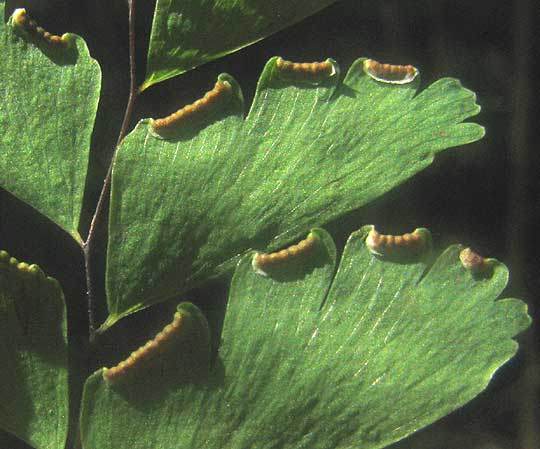Excerpts from Jim Conrad's
Naturalist Newsletter

from the August 5, 2012 Newsletter issued from the woods of the Loess Hill Region a few miles east of Natchez, Mississippi, USA
MAIDENHAIR FERN
Down in the rich-soiled, moist, heavily shaded, forested bottoms of the steep-walled ravines we call bayous in this area sometimes you can find the pretty and distinctive fern shown above. Notice its black, slender stem rising from the bottom, left. That's the Northern Maidenhair Fern, ADIANTUM PEDATUM, one of the best known and easy to recognize ferns throughout eastern North America, except for Florida and eastern Texas. Here we're not far from its southernmost point of distribution. Back in Kentucky it commonly occurred in many moist, protected habitats.
Among the many ferns we've profiled in our Newsletters we've seen that the most common manner of producing spore-producing sporangia is to gather them in distinct clusters of various shapes on the frond's undersurface. The clusters are called sori. Maidenhair ferns do something very different with their sori: Along the margins of one side of their leaflets, or pinnules, they curve the blade downward and around the sori. You can see what this looks like below:

About 200 maidenhair fern species are recognized -- 200 species of the genus Adiantum. In the Yucatan we profiled two of those species. If you enjoy experiencing "variations on a theme," you can compare our Northern Maidenhair with the Brittle Maidenhair at https://www.backyardnature.net/yucatan/britmaid.htm, and the Hairy Maidenhair at https://www.backyardnature.net/yucatan/hairmaid.htm.
If you do compare the three maidenhair species you'll see that our Northern Maidenhair stands apart from the others by the way its fanlike frond's larger divisions radiate out from the stem, or stipe. The vast majority of maidenhair fern species aren't fanlike like that. Another way to look at it is that the Northern's frond is wider than long, while the fronds of both Yucatan species exhibit the much more common aspect being longer than wide.
The Cherokee traditionally smoked the Northern Maidenhair's powdered fronds for heart trouble, and a powder of the plant was smoked and used as snuff for asthma. The Hequiat chewed its green fronds for shortness of breath, plus dancers during the winter chewed it for strength and endurance. In fact, medicinal uses among the various cultures are all over the place, with few usages held in common.
However, various cultures softened the fern's black stems for weaving into baskets to make black designs, and the Karok wove the black stems into certain of their ceremonial dresses.
The Potawatomi carried the black stems as hunting charms to bring good luck.